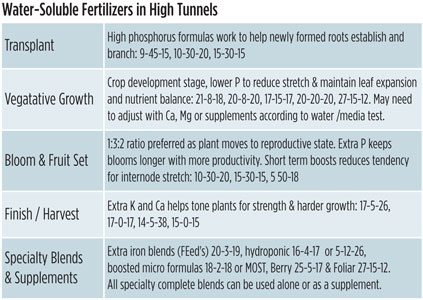1/28/2013
New Fertilizers for the Current Market
Dr. Cari Peters
Each summer as I return from OFA Short Course and several of our local trials days, I’m inspired by the newest introductions of plant material and varieties. As a breeder, these introductions represent a creative process matched with the applied science to produce varieties that “wow.” As a grower, you look for the best growing material to keep your customer niche coming back to you. As a fertilizer manufacturer, the newest varieties represent a challenge to optimize the plant nutrition either within the current fertilizer product line or beyond what’s offered.
The current arsenal of water-soluble fertilizer formulas is often very familiar to most, regardless of the name on the bag. In 2011, the all-purpose formula 20-20-20 GP represented J.R. Peters fifth top-selling product for water-soluble fertilizer. It’s estimated that almost three-quarters of current production greenhouses have at least one bag of 20-20-20, just in case. How many of us stick with the traditional staples, such as 20-10-20 and 15-5-15? As we consider the newest research and trials, the many choices of fertility can allow you maximize efficiency and plant quality of these newest varieties.

Modern water-soluble formulas are designed to unite the nutritional requirements of the latest varieties with the flexibility of using these products along with other fertility amendments. These formulas are created to give you full control and adaptability when applying nutrients, thereby taking the extra supplements and steps out of your fertility program.
To begin growing any of the newest varieties or in a new growing environment, it’s essential that you know what you’re starting with. Test the media and your water source and use the results as a baseline to make your nutrient choices. Assess the natural highs and lows in these results and choose a fertilizer formula that will complement the nutrient profile that’s recommended for the crop you’ve chosen to grow.
Specialized nutrition for new varieties
Some of the hottest crops are improvements of our favorite reliable varieties in the petunia and calibrachoa group. These plants are classified as iron-inefficient varieties. That means they have a much harder time taking up iron, especially when the root media strays outside of the 5.5 to 5.8 pH zone. Fertilizer formulas have been developed (like Jack’s Petunia FeED 20-3-19) to include extra iron from a blend of the different iron chelates, such as Fe EDTA, Fe DTPA, and Fe EDDHA. This blend keeps iron available as the pH rises above 6.2 providing available iron in the root zone for the plant to take up.
If you have high alkalinity water, you’ve probably seen the symptoms of iron deficiency at one time or another. Pale yellow newest leaves are a telltale sign that either your pH is starting to climb or you don’t have enough iron available to move to the newest growth points. Using a fertilizer formula containing this combination iron 3 chelate blend will prevent these symptoms from occurring and can also be used as periodic treatments to turn those yellow leaves back to green.

Complete nutrition for new markets
In today’s growing environment, taking advantage of opportunities is essential to a successful business. High tunnels and hydroponic systems can help growers capture a niche market of specialty customers by extending the growing season and growing specialty crops of local demand.
Focusing in on plant nutrition in a high tunnel or hydroponic environment can include many concepts from organic to mineral to eco-friendly options. Often, high-tunnel growers are told to use “garden or agriculture” fertilizers and adapt them to a high-tunnel environment. However, the key to optimizing your plants’ performance nutritionally is to ensure you choose nutrient sources that are balanced and available for the plant to take up. A good, balanced nutritional profile can come from one “complete” bag of fertilizer or a combination of different amendments. The result should contain all macro, secondary and the ever-so-essential micronutrients.
Smart fertilizer
Cultural practices today are moving toward a more sustainable and efficient growing method. Keeping that in mind, we’ve found that in order to save money and become more efficient, growers have reduced their overall fertilization rates. Interestingly enough, the newest varieties of plants seem to still perform well at lower concentrations of constant feed. What we’ve observed is there aren’t as many macronutrient deficiencies at this lower rate; rather more micronutrient deficiencies as the overall feed rate skims the lower limit of these trace element thresholds.
In response, one of the most recent introductions on the market is Jack’s 18-2-18 Boosted Base FeED. It’s targeted to be used at 125 ppm constant liquid feed, in situations where there’s ample calcium in the water source. At this lower feed rate, the formula is designed with two times the overall micronutrient package when compared to a typical 20-10-20 Peat-Lite formula. This adjustment allows the grower to feed less on a constant liquid feed or period program while still delivering an enhanced micronutrient level to the plant.
Attention to details, when it comes to the plant’s nutrition is key to creating the optimum growing environment in a greenhouse, hydroponic system or high tunnel. When choosing your nutrient source, it’s essential to strive for the highest quality, best control and most efficient way to deliver nutrients to the root zone. It may surprise you how easy and effective a switch to some of the newer formulas may be for your production.
GT
Dr. Cari Peters is Vice President of J.R. Peters, Inc. based in Allentown, Pennsylvania. She can be reached at caripeters@jrpeters.com.